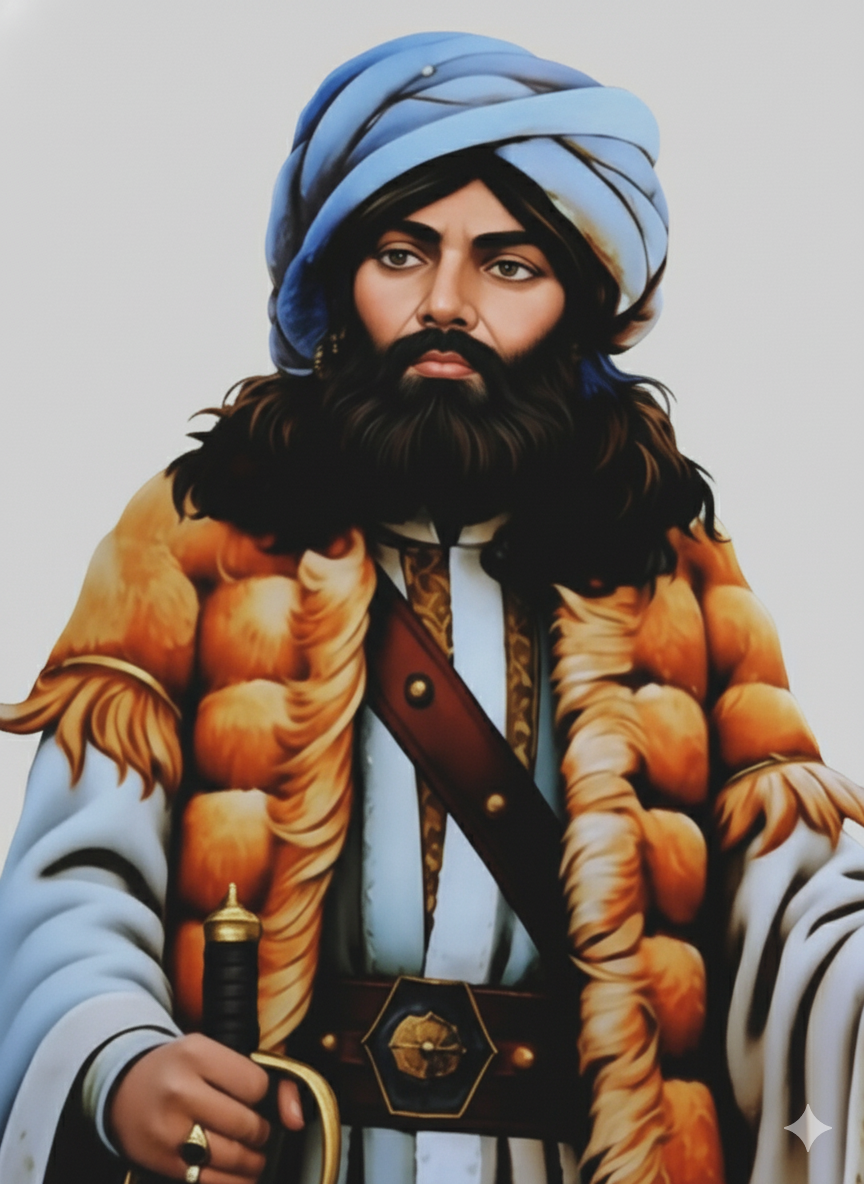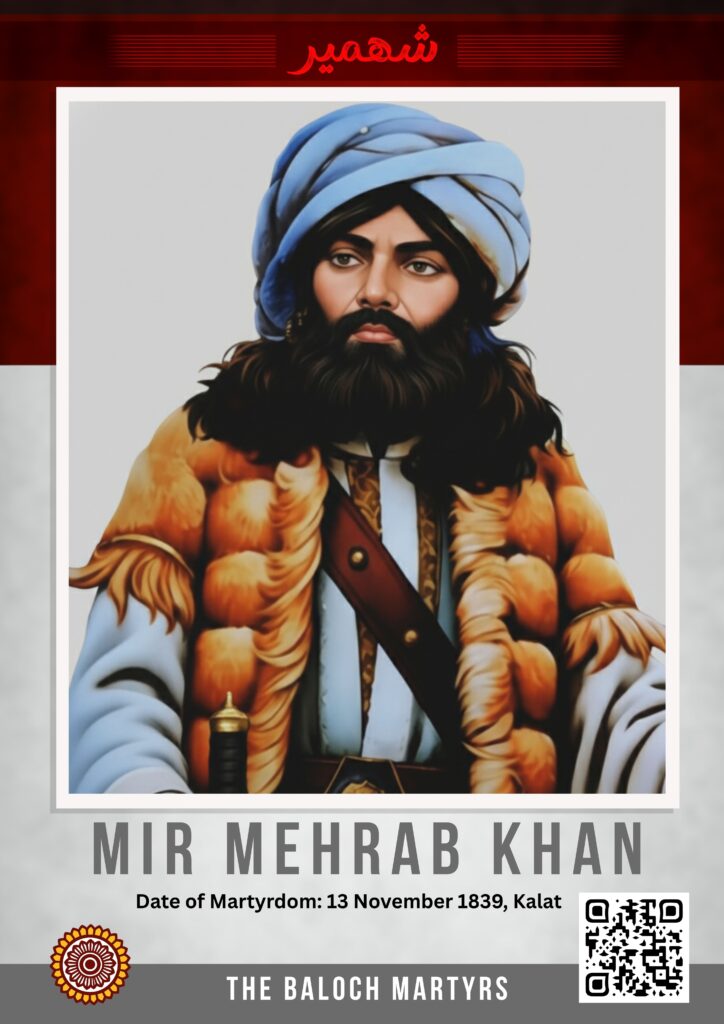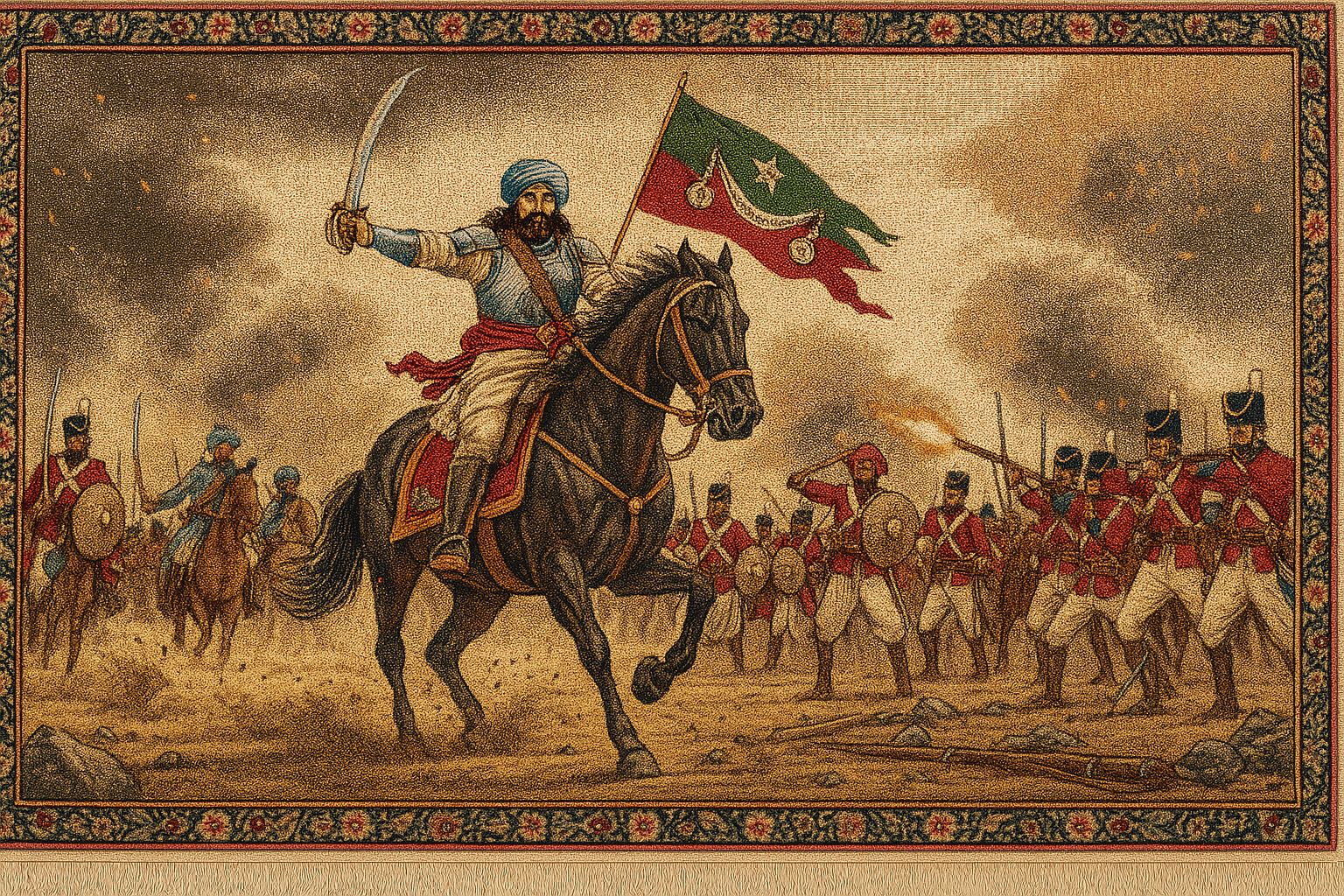Profile
Lal Shaheed Mir Mehrab Khan Ahmadzai II
لال شھید میر محراب خان احمد زھی

| Born | Kalat, Balochistan |
|---|---|
| Date of Martyrdom | 13 November 1839, Kalat, Balochistan |
| Occupation | Khan of Balochistan (King of Balochistan ) |
| Era | 1817–1839 |
| Organization / Domain | Hukumat-e-Balochi (The Baloch Government) |
| Known For | Defending Baloch sovereignty against British invasion; symbol of national resistance and martyrdom. |
| Title / Alias | Lal Shaheed (The Crimson Martyr), Khan Baloch |
| Family Background | Grandson of Mir Noori Naseer Khan; Son of Mir Mahmood Khan I, from the Ahmadzai ruling family of Kalat. |
Khan Baloch Lal Shaheed Mir Mehrab Khan Ahmadzai II was the King (Khan) of Balochistan. The Ahmadzai rulers of Balochistan referred to their rule as “Hukumat-e-Balochi” (The Baloch Government), and their sovereign title was Khan Baloch. Mir Mehrab Khan ruled from approximately 1817 until his martyrdom on 13 November 1839.
- Profile
- Lal Shaheed Mir Mehrab Khan Ahmadzai II
- The British Invasion Plan Through Balochistan — and the Khan’s Resistance
- The Mission of Sir Alexander Burnes
- Burnes’s Report on Mehrab Khan
- The Siege of Kalat and the Martyrdom of the Khan Baloch
- According to Willshire himself:
- The Martyrs of Kalat
- Legacy of Lal Shaheed
- Download
- Photo Gallery
He ascended the throne at a time when the Hukumat-e-Balochi was plagued by internal dissension and external conspiracies.
The Baloch Government had reached the peak of its glory during the reign of Khan Baloch Mir Noori Naseer Khan
in the 1750s. He transformed Balochistan into a united and powerful state. Through his courage, wisdom, and political insight, he liberated Balochistan from Afghan domination and established friendly relations with Afghanistan instead of the typical conqueror–subject dynamic. When asked about the borders of Balochistan, he famously replied:
“Wherever even a single person speaks Balochi, that is the boundary of Balochistan.”
Mir Mehrab Khan was the grandson of Mir Naseer Khan and the son of Mir Mahmood Khan I. His reign was marked by internal divisions and power struggles among neighboring states.
According to Arthur Conolly, Mehrab Khan desired friendly relations with Maharaja Ranjit Singh, the powerful ruler of Punjab, while also wishing to see the restoration of the Sadozai dynasty in Afghanistan.
To consolidate his authority, Mir Mehrab Khan dismissed his influential hereditary vizier, Fateh Muhammad, which led to a series of tragic events. Fateh Muhammad’s son, Mullah Muhammad Hassan, later avenged his father’s dismissal by killing Daud and reclaiming the hereditary vizierate. However, Mullah Muhammad Hassan never forgave the wrong done to his father, and the misfortunes that later befell Mehrab Khan are believed to have been the result of his revenge.
The British Invasion Plan Through Balochistan — and the Khan’s Resistance
When the British proposed that Khan Baloch assist them in restoring Shah Shuja to the Afghan throne and allow their forces to pass through Balochistan, the Khan firmly refused. He told them:
“Shah Shuja should rely on his own people to regain his throne. His alliance with the Indians in their quest for territorial expansion is an insult his nation will never forgive. This plan will never succeed. You English may seat him on the throne for a short while through your military might, but once you leave, he will be driven from his borders. He will never withstand the storm of national and religious hostility that already rages in the hearts of Afghans against him.”
The Mission of Sir Alexander Burnes
Captain Sir Alexander Burnes (1805–1841) was sent to Kalat to end the supposed enmity with the Khan and negotiate a formal treaty—recorded as Treaty No. CLXXIII.
Burnes was en route to Shaal when he was attacked by Baloch forces, who seized the treaty papers bearing the Khan’s signature. The British became convinced that the assault had been carried out on Mehrab Khan’s orders. To them, this incident served as proof of his “hostility” and provided the pretext they needed for invasion.
Burnes’s Report on Mehrab Khan
Alexander Burnes, with the typical colonial mindset, described Mir Mehrab Khan in prejudiced terms, though his own report inadvertently acknowledged Balochistan’s independence. He wrote:
“Among the rulers along Sindh’s frontier, Amir Mehrab Khan of Kalat and Gandawah maintains the closest ties. Once a tributary of Kabul, he now controls a brave nation and a strong territory between his domain and that of the Amirs. Afghan rulers have tried to win him over with bribes and promises, but he remains independent and ever ready to assist Sindh in protecting its borders.
His marriage alliance links him to the ruling family of Hyderabad, and since the Brahuis and Baloch consider themselves of one lineage, their interests are mutual. His relations with the Sikhs of Lahore are neither cordial nor extensive—he fears Ranjit Singh’s power yet avoids offending the Afghan royal family. The Maharaja has never demanded his submission, nor has he ever offered it. Yet he is well aware that Punjab is the only neighboring region from which an attack could easily be launched. His eastern relations with Rajput rulers are limited to exchanges of gifts.”
Despite Burnes’s bias, even his report implicitly recognized Balochistan as an independent sovereign state.
After the attack on Burnes, the British sent an insulting letter summoning Mehrab Khan to Shaal. The Khan responded harshly and refused to appear before them. Offended, the British accused him of two things: insulting Sir Alexander Burnes during their meeting and stealing a chest containing the treaty copy and 2,000 rupees.
On 4 November 1839 , British forces—armed with cannons and led by General Willshire—marched toward Kalat. Their force included 65 British and 12 Indian officers.
The Siege of Kalat and the Martyrdom of the Khan Baloch
When Khan Baloch learned of the impending assault, he sent appeals to the tribal chiefs of Balochistan for help in defending the homeland. But one by one, they refused. To one chief, the Khan even sent his daughter as an emissary, yet no aid came. Many chiefs went so far as to welcome the advancing British general, Willshire, along the route, supplying him with food, fodder, camels, and horses.
It was the month of Ramadan when Kalat was besieged. British artillery bombarded the city and the fort with relentless fire. The invaders, devoid of any sense of honor or ethics, launched a full-scale assault. Major Pennycook attacked the Kandhari Gate, while General Willshire stormed the northern entrance.
According to Willshire himself:
“The enemy (the Baloch) fought step by step with the utmost bravery, perseverance, and passion. They resisted even within the inner fort, contesting every inch of ground. The defense of Kalat was stronger than that of Ghazni. The garrison exceeded two thousand men. I regret to say that our losses in dead and wounded were severe.”
Finally, the British cannons shattered the walls of the Kalat fort. But the proud Khan Baloch Lal Shaheed Mir Mehrab Khan and his noble companions, unacquainted with surrender, drew their swords and charged into hand-to-hand combat. Amid the dust, smoke, and war cries, they fought until the end—choosing death over dishonor.
Leading seven hundred warriors, Mir Mehrab Khan fought with his sword drawn, delivering a resistance so fierce that even Kalat itself seemed to weep for the loss of its valiant master. Swords and daggers flashed; shields clanged; bodies fell; heads rolled; and the cry of faith thundered through the air. Then, at noon on 13 November 1839, the strongest neck of the Baloch nation was severed—Mir Mehrab Khan, still gripping his sword, embraced martyrdom.
The Martyrs of Kalat
Among those who attained martyrdom that day were:
Abdul Karim Raisani (brother of Sardar Asad Khan Raisani), Sardar Wali Muhammad Shahizai Mengal (uncle of Mir Mehrab Khan), Mir Taj Muhammad Shahizai Mengal (cousin of the Khan), Mir Muhammad Ali Shahizai Mengal, Mir Pazal Muhammad (brother of Sardar Muhammad Khan Lehri), Sardar Zaman Khan Pandrani, Mir Dad Karim Chandiozai Shahwani, Mir Shahbaz Khan Nichari, Mir Badal Khan (brother of Sardar Shahbaz Khan Nichari), Khan Muhammad Dehwar (citizen of Kalat), Mir Nabi Bakhsh Jatoi of Narmak, Mir Qaisar Khan Bizenjo, Mir Shah Dost Bizenjo, Muhammad Raza Wazir Khail, Noor Muhammad Shahizai (son of Bolat Sagaar Sarmastani, keeper of the armory), Taj Muhammad Shaghasi, Diwan Bacha Mal (Minister of Finance), Diwan Khem Chand, and Diwan Asardas, head of the Hindu Panchayat of Kalat.
Alongside them, over 400 other Baloch warriors embraced martyrdom. Many others whose names are not recorded belonged to the tribes of Mengal, Zehri, Muhammad Hassani, Shahwani, Bangulzai, Qalandrani, Gargnari, Samalani, Mirwani, and Kambrani
The British lost 32 men, including Lieutenant Grewitt, while 107 were wounded , of whom 37 later died—roughly one in every six soldiers engaged. The Baloch gave their enemies no easy passage.
Legacy of Lal Shaheed

With deep reverence, the people of Balochistan remember this breaker of falsehood as “Lal Shaheed” — The Crimson Martyr. To the Baloch, he is a symbol of truth and sacrifice, much like the great martyrs of every nation who gave their lives for their homeland.
The title Lal signifies one who is killed without guilt in the struggle for truth and justice.
Every year, on 13 November, the Baloch commemorate “Baloch Martyrs’ Day” to honor Khan Baloch Mir Mehrab Khan and his brave companions.
This day is not merely a remembrance of Lal Shaheed’s resistance; it is the story of the Baloch nation’s eternal bond with their land—the story of sacrifice that continues to inspire pride, faith, and fidelity in every Baloch heart.
Note : This article draws inspiration from the writings of Shah Mohammad Marri.
Download
Photo Gallery
Khan Baloch Lal Shaheed Mir Mehrab Khan

Khan Baloch Lal Shaheed Mir Mehrab Khan

Khan Baloch Lal Shaheed Mir Mehrab Khan

Khan Baloch Lal Shaheed Mir Mehrab Khan

Khan Baloch Lal Shaheed Mir Mehrab Khan

Khan Baloch Lal Shaheed Mir Mehrab Khan

Khan Baloch Lal Shaheed Mir Mehrab Khan



